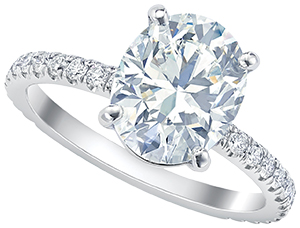|
|
Cover

Retail Rap
By Phyllis Schiller

|
| Forevermark Black Label |
The 4Cs are not the only things that make a piece of diamond jewelry a sales winner. In an ongoing series, Rapaport Magazine explores the “3Ws” — what’s selling, what’s not and why — by going straight to the people who really know — jewelry retailers. Each month, we ask a sampling of retailers to comment on the important issues that are facing the industry today. Here is what they had to say when asked: “What styles of engagement rings —shapes, settings and metals — are most popular today?”
“Actually, it’s been ovals that have been very strong for us, bigger ovals — we’re selling a lot of 1.5 carats to 2 carats. And cushions are still going. Halos remain very big but we’re seeing a slow trend back to cathedrals and solitaires.
“In terms of metal, it’s still white gold. There seems to be a little trend toward yellow, but it’s still 75 percent to 80 percent white, gold or platinum but mostly white gold.”
“We have sold two diamond insert rings this week; I used to sell those 20 years ago. We’ve been getting requests for fancies — oval, Asscher, radiants. But people do end up more in rounds. And it’s still white gold. We are doing more custom bridal. Either they’re bringing in a family diamond and we’re designing a mounting or a custom setting helps them find a new diamond. We’re staying busy in bridal in the creation and customization; it’s certainly outpacing clients buying rings out of the case.”
“We’re still seeing a lot of halo rings right now and there’s still a lot of interest in rose gold in our market. Ovals and pears have been popular recently. Vintage is still there to an extent. We’re seeing a lot of twisted or split shapes, kind of the infinity look. That has been popular.”
“I would say a lot of the vintage stuff is still sticking around, millegrain, things like that. A lot of people are planning on stackable wedding bands and more unusual bands to go with their rings. Halos are still there but I am seeing more solitaires, single diamonds, steering away from the halos a little more. I’m also seeing alternative gemstones being used for center stones — anything that’s on Pinterest. Rose gold is pretty hot right now. And with that rose gold trend, a lot of rings with morganite center stones are being posted. I steer everyone away from putting a morganite center stone in anything to be worn every day and instead suggest using something like a sapphire. We just recently did a padparadscha center stone, which is very odd. But the client wanted a peach color center stone.
“I’m seeing a lot of different shapes, more elongated shapes such as ovals. The pear shape got really hot for a while. I still make a couple of them, but it’s dwindling a bit. White is still the most prominent metal — we’re steering a lot of people into platinum nowadays just because it’s so low in price but the majority of sales are still probably 14-karat white gold because it’s less expensive.”
“It’s been more rose gold — up to 20 percent — still a lot of platinum and a lot of ovals recently. The last three rings we designed were oval stones, half-carat to a carat. Still selling rounds well but I would say that the trend toward ovals is certainly there. I haven’t sold a princess cut probably since 2016, which is surprising. In terms of fancy shapes, we’ve sold one Asscher in the past quarter. The majority of the settings are still white.
“The halo is around and still selling, but less so. We’re seeing more people gravitate toward nonprecious centers and non-halos so they can get a bigger look. We can blame Pinterest for that, showing morganite. We do warn them about the softness of the stone. It’s a small percentage but it’s certainly happening. And a lot of people want rings that are too fine to hold up — too thin, too narrow. I tell them they’re at the wrong place for that. We want to sell them something that will last and be trouble free.
We own an antique brand called Van Craeynest and a lot of that is in yellow and antiquing. It’s a die-struck line from the 1920s we make today in the same way as back then, with the same equipment, right here in our store. We make a few hundred of those a year.”
“We are in the middle of Illinois — farm country — and we are about six months to a year behind everyone else. For us, it’s still white gold and halo and princess cuts. In terms of sizes, we actually cater to the smaller stones. We like .50 carats to .75 carats.
“We didn’t get on the vintage bandwagon; we knew it was going to be short-lived and were thankful we didn’t get involved with all those tiny stones. They’re still popular but that vintage look went quick. My custom work over the past four or five years is up 40 percent. We’re custom making probably 200 to 300 pieces a year and we’re a small store. Custom is continuing to go up. It’s just a $200 or $300 difference, so why not customize?”Article from the Rapaport Magazine - April 2017. To subscribe click here.
|
|

|
|